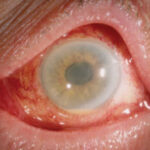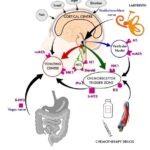Post-operative photophobia refers to abnormal light sensitivity experienced following ocular surgery. While some degree of photophobia may be transient and expected, persistent or severe symptoms warrant clinical investigation. Photophobia can emerge after procedures such as LASIK, cataract surgery, corneal transplants, or vitrectomy, indicating underlying inflammation, nerve hypersensitivity, or surgical complications.

Common Causes of Post-Op Photophobia
1. Corneal Nerve Disruption
Eye surgeries, especially LASIK or PRK, disrupt the corneal nerves, leading to heightened sensitivity as the nerves regenerate. This neuropathic pain often presents as prolonged photophobia.
2. Postoperative Inflammation
Inflammatory conditions like anterior uveitis or iridocyclitis can irritate the iris and ciliary body, both involved in pupil constriction and light regulation.
3. Dry Eye Syndrome
Post-surgical tear film instability is common, particularly after refractive surgery. Inadequate lubrication increases ocular surface irritation, exacerbating light sensitivity.
4. Posterior Capsular Opacification (PCO)
Intraocular lens patients may develop PCO, a common complication following cataract surgery, causing glare and photophobia.
5. Phototoxicity
Excessive intraoperative light exposure from the microscope or laser devices can damage the retina or cornea, resulting in prolonged sensitivity to light.
6. Residual Refractive Error
Incorrect lens placement or uncorrected astigmatism may result in light scattering, halos, or glare contributing to photophobia.
Recognizing Symptoms and Patterns
Photophobia manifests variably depending on the surgical type, complications, and individual healing response.
Key Symptoms:
- Discomfort or pain in response to ambient or artificial light
- Squinting or closing eyes when exposed to light
- Watery eyes and blurred vision under bright conditions
- Headaches triggered by light exposure
- Burning or foreign body sensation
Diagnosis of Post-Surgical Photophobia
Accurate diagnosis involves both subjective symptom evaluation and objective clinical findings.
Diagnostic Workflow:
1. Patient History
- Type and date of surgery
- Presence of dry eye, pain, or visual disturbances
- Onset and duration of symptoms
2. Slit Lamp Examination
- Assess for corneal defects, inflammatory cells, lens opacities, and tear film abnormalities
3. Ocular Surface Tests
- Schirmer’s test and Tear Break-Up Time (TBUT) to evaluate dry eye
- Fluorescein staining to detect epithelial disruption
4. Optical Coherence Tomography (OCT)
- Imaging of the anterior segment, retina, and macula to rule out edema or structural damage
5. Corneal Confocal Microscopy
- Evaluates nerve fiber density and neuropathy in persistent cases
Treatment and Management of Post-Op Photophobia
The therapeutic approach is determined by the underlying etiology.
1. For Dry Eye-Related Photophobia
- Artificial tears (preservative-free)
- Punctal plugs to reduce tear drainage
- Lipid-based eye drops for evaporative dry eye
- Cyclosporine or lifitegrast for inflammation control
2. For Inflammation-Induced Photophobia
- Topical corticosteroids (e.g., prednisolone acetate)
- Cycloplegic drops to reduce ciliary spasm
- Non-steroidal anti-inflammatory drugs (NSAIDs)
3. For Neuropathic Photophobia
- Neuro-modulating agents such as gabapentin or pregabalin (off-label use)
- Autologous serum eye drops to promote nerve regeneration
- Blue light-blocking glasses to reduce light-triggered symptoms
4. Addressing Residual Refractive Errors
- Spectacles or contact lenses
- Refractive correction procedures, if appropriate
Prognosis and Patient Education
Most patients experience resolution or improvement within a few weeks post-surgery, particularly when inflammation or dry eye is treated early. Persistent photophobia beyond three months may suggest neuropathic causes, requiring advanced therapies and specialist referral.
Patient Guidance:
- Avoid direct sunlight and bright environments during early recovery
- Use UV-protective sunglasses
- Maintain adherence to postoperative medication regimens
- Attend scheduled follow-up visits for early detection of complications
Preventive Strategies for Minimizing Photophobia After Surgery
Surgical Precision:
- Gentle tissue handling and minimal exposure to bright intraoperative light
- Optimal lens placement and wound closure
Preoperative Planning:
- Identify preexisting dry eye, blepharitis, or inflammatory diseases
- Treat ocular surface disease prior to surgery
Postoperative Care:
- Regular lubrication
- Monitor and manage inflammatory markers
- Educate patients on potential photophobia symptoms
Post-operative photophobia is a multifactorial complication that requires a tailored, etiology-specific approach. Whether the result of ocular surface dryness, nerve hypersensitivity, or residual inflammation, early recognition and targeted therapy can ensure patient comfort and visual rehabilitation. A coordinated strategy involving diagnosis, treatment, and prevention is essential to minimizing discomfort and improving post-surgical outcomes.

